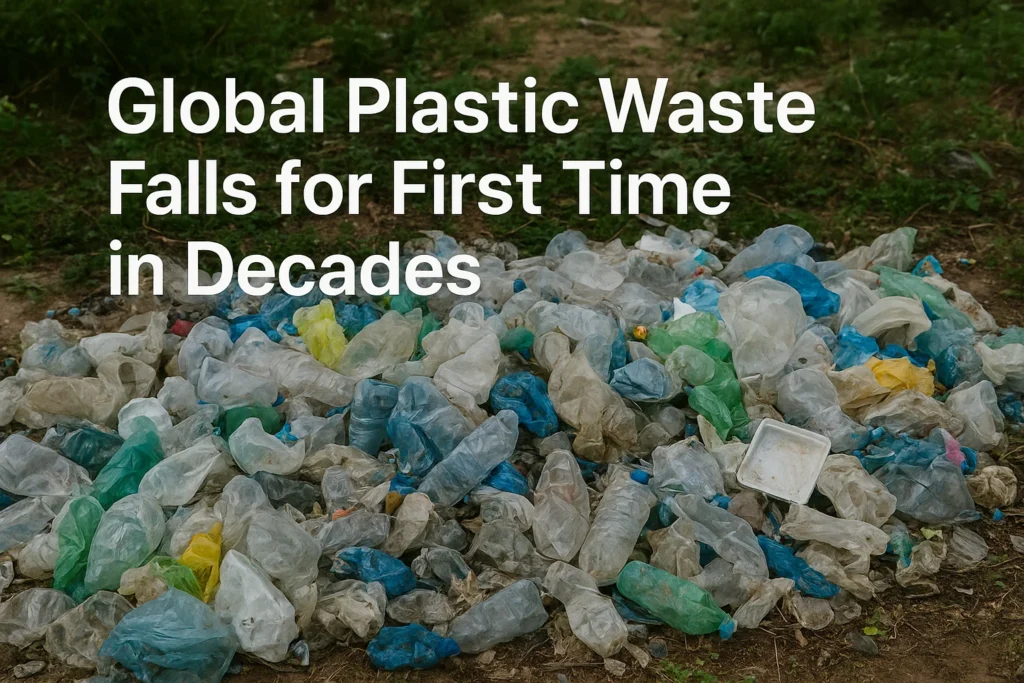There is a moment in any great struggle when the momentum shifts. For decades, the world’s battle against plastic waste has felt like a futile effort, a desperate attempt to hold back a rising tide with bare hands. The statistics were relentless, the images of polluted oceans and choked wildlife were heartbreaking, and the trajectory seemed unchangeable. We were living in the Plastic Age, and it appeared there was no end in sight.
Then, a report from the United Nations delivered a piece of news so unexpected that it sent ripples through the environmental community, policy circles, and across the globe. For the first time since such records have been kept, the generation of global plastic waste has not just plateaued—it has actually decreased.
This is not a minor statistical blip. It is a landmark event, a sign that the collective actions of billions of people, thousands of organizations, and hundreds of governments are finally aligning to change the course of history. This is the story of how that happened—a tale of innovation, policy, and a profound shift in human behavior. It is a story that proves no problem is too big to solve when we decide to truly address it.
The Plastic Paradox: A Miracle Material’s Dark Side
To understand the sheer magnitude of this achievement, we must first journey back to the origins of our plastic world. The development of synthetic polymers in the early 20th century was hailed as a revolutionary advancement. Bakelite, introduced in 1907, became the first synthetic plastic, transforming manufacturing with its insulating and durable properties.
But the real explosion came after World War II. The petrochemical industry, fueled by wartime production, turned its attention to consumer goods. Plastic promised a future of convenience, hygiene, and affordability. It revolutionized medicine with sterile single-use equipment, made vehicles lighter and more fuel-efficient, and transformed food preservation—dramatically reducing spoilage and enabling global distribution networks.
The plastic shopping bag, introduced in the 1970s, was even marketed as an environmental alternative to paper bags that would save trees. We embraced plastic with open arms, captivated by its versatility and blind to its long-term consequences.
The problem was fundamental: plastic’s greatest strength was also its greatest weakness. Its durability and resistance to degradation—the very properties that made it so useful—meant it persisted in the environment for centuries. A plastic bottle used for five minutes would outlive its user by hundreds of years.
We built a “throwaway culture” on the assumption that things could simply be discarded and would disappear. The system was brutally linear: extract fossil fuels from the ground, manufacture them into plastic products, use them briefly, and discard them permanently.
The numbers tell the story of this addiction:
- Half of all plastics ever manufactured have been produced in just the last 20 years
- Annual production has exploded from 2 million metric tons in 1950 to over 400 million metric tons today
- Approximately 12 million metric tons enter our oceans annually—the equivalent of a garbage truck full of plastic being dumped into the sea every minute
- Less than 10% of all plastic ever produced has been recycled
- The rest persists in landfills, environments, and increasingly, in the bodies of living creatures
For decades, the graph of plastic waste production showed nothing but an upward trajectory—a line that seemed destined to climb forever. It represented what many believed was an unsolvable problem of modern civilization.
The UN Report: The Data Point That Changed the Narrative
In the world of environmental monitoring, data reports are published constantly. Most are read by specialists, summarized for policymakers, and added to the growing body of evidence about our changing planet. But occasionally, a report contains a finding so surprising, so counter to established trends, that it changes the entire conversation.
The United Nations Environment Programme’s (UNEP) latest Global Plastic Waste Assessment contained exactly such a finding. Buried among its detailed analyses and projections was a simple, astonishing statement: for the first time in recorded history, the annual generation of global plastic waste had declined.
This wasn’t a forecast or a hopeful model—it was empirical data based on actual measurements. The trend that had defined the Plastic Age had been broken.
The report carefully contextualized this finding. The drop, while statistically significant, represents a fragile beginning rather than a final victory. We still produce a staggering amount of plastic waste—hundreds of millions of tons annually. The existing plastic pollution in our environments will persist for centuries. But for the first time, we are not adding to the problem at an accelerating rate. We have begun to reduce the flow.
According to UN analysis, this reversal stems from two powerful forces working in tandem: aggressive government policies and bans on single-use plastics, and revolutionary advances in recycling technology and infrastructure. This combination of top-down regulation and bottom-up innovation created the perfect conditions for change.
The Policy Revolution: How Bans and Regulations Are Cutting Plastic at the Source
The most significant driver of the waste reduction has been a global movement to target the most visible and problematic category of plastics: single-use items. These are the products designed for moments of convenience but made to persist for centuries—straws, bags, cutlery, food containers, and packaging.
The Pioneers: Nations That Led the Way
Long before plastic pollution became a mainstream concern, a few visionary nations took bold steps that seemed radical at the time.
Rwanda’s Green Vision: In 2008, Rwanda implemented one of the world’s strictest bans on non-biodegradable plastic bags. The legislation was comprehensive, prohibiting their manufacture, import, sale, and even use. The government enforced these rules stringently, with border checks and significant penalties for violations. Skeptics wondered whether a developing nation could successfully implement such ambitious environmental policies. The results proved them wrong. Kigali, Rwanda’s capital, is now consistently ranked among the cleanest cities globally. The plastic bag ban became a source of national pride, demonstrating that environmental stewardship could be central to a country’s identity and public health strategy.
Kenya’s Strong Stance: Following Rwanda’s example, Kenya introduced its own drastic ban in 2017, imposing some of the world’s toughest penalties: fines of up to $40,000 or prison sentences for manufacturing, selling, or even carrying plastic bags. The transformation was immediate and visible. Plastic bags that had clogged drainage systems, caused flooding during rains, and been dubbed “the national flower” largely disappeared from urban and rural landscapes. The ban forced a rapid cultural adaptation, with citizens embracing reusable alternatives made from traditional materials.
The Power of Collective Action: The European Union’s Comprehensive Approach
While individual nations demonstrated what was possible, the real game-changer came when major economic blocs entered the fray. In 2019, the European Union passed the Single-Use Plastics Directive, arguably the most comprehensive legislation addressing plastic pollution to date.
The directive employed a sophisticated multi-pronged strategy that went far beyond simple bans:
- Outright prohibition of the most common problematic single-use items
- Measurable reduction targets for other plastic products
- Extended Producer Responsibility requirements making manufacturers financially accountable for the waste management of their products
- Mandatory recycled content requirements for plastic bottles
- Awareness campaigns and labeling requirements to inform consumers
This comprehensive framework demonstrated that effective policy could be more than just prohibition—it could create an entire ecosystem of incentives and responsibilities that drove innovation and behavioral change.
The Ripple Effect: How Policy Changes Markets and Minds
The impact of these regulations extends far beyond the immediate removal of specific items from circulation. They create powerful economic signals that ripple through global supply chains and consumer markets.
Spurring Innovation: When traditional plastic materials become unavailable or more expensive due to regulations, companies are forced to innovate. This has catalyzed an explosion of alternative materials and delivery systems. Today, we see edible utensils, seaweed-based packaging, mushroom-derived insulation materials, and plant-based polymers that compost completely. What began as niche experiments are now scaling into viable industries.
Changing Consumer Behavior: Regulations help break old habits and establish new norms. When supermarkets charge for bags or eliminate them entirely, shoppers remember to bring their own. When restaurants switch to paper straws, customers adapt. These forced behavior changes eventually become unconscious habits, creating a cultural foundation for broader environmental consciousness.
Leveling the Competitive Landscape: Comprehensive regulations ensure that no company is disadvantaged for doing the right thing. When all manufacturers must comply with the same environmental standards, sustainability becomes integrated into business models rather than being a competitive disadvantage.
This global network of policies has effectively amputated the largest sources of plastic pollution at the source, preventing millions of tons of waste from ever entering the system.
The Technology Transformation: How Smart Recycling Is Closing the Loop
While policies stop waste at the source, the second pillar of progress addresses the plastic that remains in circulation. For decades, recycling has been the well-intentioned but troubled component of waste management—plagued by contamination, confusion, and economic challenges. Today, a technological revolution is transforming recycling from a moral choice into a smart, efficient system.
Beyond Manual Sorting: The AI-Powered Recycling Facility
The traditional image of recycling—workers manually sorting through moving conveyor belts of waste—is rapidly becoming obsolete. A new generation of Material Recovery Facilities (MRFs) is leveraging cutting-edge technology to achieve unprecedented levels of efficiency and purity.
AI and Optical Sorting: Modern facilities deploy networks of high-resolution cameras connected to artificial intelligence systems that can identify specific types of plastic in milliseconds. These systems distinguish between PET, HDPE, PVC, and other resins with accuracy far exceeding human capabilities. Robotic arms and targeted air jets then separate materials at incredible speeds, creating streams of recycled material pure enough to compete with virgin plastics.
Combating Contamination: “Wishcycling”—the practice of placing non-recyclable items in recycling bins hoping they can be recycled—has long been the Achilles’ heel of recycling systems. New technologies are addressing this through public education apps that identify what can be recycled, and even smart collection trucks that can detect and reject contaminated bins before they’re emptied.
Chemical Recycling: The Game Changer
The most promising technological advancement is chemical recycling (also called advanced recycling), which represents a paradigm shift in how we view plastic waste.
Unlike traditional mechanical recycling—which involves washing, shredding, and melting plastic, often resulting in downgraded quality—chemical recycling uses processes like pyrolysis, depolymerization, and gasification to break plastics down to their molecular building blocks. This creates raw materials that are chemically identical to those made from fossil fuels.
The potential implications are profound:
- Ability to recycle previously “unrecyclable” plastics like flexible films and multi-layer packaging
- Creation of a truly circular system where plastic can be recycled indefinitely without quality loss
- Reduction in reliance on virgin fossil fuels for plastic production
- Diversion of complex plastic waste from landfills and incinerators
While the technology is still scaling and faces economic and environmental questions, it represents a fundamental reimagining of plastic waste not as trash, but as a valuable resource.
The Circular Economy: Redefining Our Relationship with Materials
Underpinning these technological advances is a philosophical shift from a linear economy to a circular economy.
The traditional model is Take-Make-Waste: extract resources, manufacture products, use them, and discard them.
The circular model is regenerative by design: products are created to be durable, repairable, and—at end of life—fully recyclable into high-quality materials. Waste is designed out of the system entirely.
This concept is being embraced at corporate levels, with major brands setting ambitious targets for using post-consumer recycled content, redesigning packaging for recyclability, and exploring innovative delivery models like reusable container systems.
This economic shift creates the market demand that makes advanced recycling technologies financially viable, connecting intention with implementation.
The Persistent Challenges: Why This Is Just the Beginning
While the decline in plastic waste generation represents extraordinary progress, it would be dangerously premature to declare victory. Significant, complex challenges remain that will require even greater innovation and cooperation.
The Scale of the Existing Problem
Even with reduced waste generation, the sheer volume of plastic already in our environment is overwhelming. Hundreds of millions of tons continue to be produced annually. The plastic pollution already in our oceans, landscapes, and landfills will persist for centuries, continuously breaking down into microplastics that infiltrate every ecosystem on Earth—from the deepest ocean trenches to the highest mountain peaks, and increasingly, our own bodies.
The Global Inequality Issue
Progress is not uniform across the world. While many high and middle-income countries are implementing advanced waste management systems, the situation remains critical in much of the developing world.
Waste Infrastructure Gaps: Many rapidly growing economies lack formal waste collection and management systems to handle their own plastic waste, let alone manage imported waste from wealthier nations.
Economic Pressures: The appeal of cheap, convenient plastic packaging remains powerful for economies focused on development and poverty reduction. Sustainable alternatives are often perceived as luxury items rather than accessible solutions.
The Legacy of Waste Colonialism: For decades, wealthy nations exported their plastic waste to developing countries, overwhelming their environments and leading to widespread open burning and dumping. While new international agreements are curbing this practice, the damage has been done, creating pollution hotspots that will require generations to clean up.
The Microplastics Crisis
Even if we stopped all plastic waste today, the problem of microplastics would persist. These tiny particles—shed from synthetic clothing, vehicle tires, and the breakdown of larger items—have become pervasive pollutants. They are in the air we breathe, the water we drink, and the food we eat. The full impact on human health and ecosystems remains largely unknown and represents a frontier of scientific research.
Greenwashing and False Solutions
As public concern about plastic pollution has grown, so has “greenwashing”—misleading environmental claims used for marketing advantage. Companies may promote token sustainability efforts while continuing business-as-usual, or advocate for unproven technological solutions that delay meaningful action. Distinguishing genuine progress from marketing spin remains a critical challenge for consumers and policymakers.
The Power of the Individual: How Everyday Choices Create Global Change
Faced with a challenge of this magnitude, it’s easy to feel that individual actions cannot make a difference. The UN report proves otherwise. This historic turnaround is the direct result of billions of individual decisions amplified by policy and innovation. Every person has a role to play in continuing this progress.
Embrace the Reusable Mindset
The most effective way to reduce plastic waste is to avoid creating it in the first place. Cultivate the habit of carrying four essential reusables: a water bottle, coffee cup, utensils, and shopping bags. These simple items can eliminate the majority of single-use plastic encounters in daily life.
Become a Recycling Expert
Recycling right is more important than recycling more. Take time to understand your local recycling guidelines—rules vary significantly by community. Remember to rinse containers thoroughly, as food residue can render materials unrecyclable. When in doubt about an item’s recyclability, leave it out rather than risk contaminating an entire batch.
Support Sustainable Businesses
Use your purchasing power to support companies that demonstrate genuine commitment to reducing their plastic footprint. Look for transparent reporting, meaningful recycled content targets, and innovative packaging solutions. Your buying decisions send direct signals to the market about what values matter.
Practice Conscious Refusal
Politely refusing unnecessary plastic—whether straws, utensils, or excessive packaging—is a small but powerful act. Each refusal reinforces your own habits and signals to businesses that consumer expectations are changing.
Amplify Your Impact Through Advocacy
Individual actions become collective power when they’re scaled through policy. Support organizations working on plastic pollution issues. Contact elected representatives to express support for extended producer responsibility laws, plastic reduction targets, and waste management infrastructure. Participate in local cleanups and awareness campaigns. Your voice helps create the political will for systemic change.
A Turning Point, Not an End Point
The news of declining plastic waste generation is not a victory declaration. It is a validation—proof that change is possible when humanity directs its creativity and will toward a common goal. We have demonstrated that the seemingly unstoppable tide of plastic pollution can indeed be turned back.
The mountain of plastic we’ve created over decades remains with us, and the path forward requires even greater commitment and innovation. But for the first time, we have tangible evidence that our efforts are working. The graph has bent. The trajectory has changed.
This milestone represents something more significant than just improved waste management statistics. It represents a shift in our relationship with the material world—from mindless consumption to conscious stewardship, from linear extraction to circular regeneration, from hopelessness to agency.
The turning point is here. Now comes the work of accelerating the decline, cleaning up what remains, and building an economy where waste is designed out of existence. The plastic age doesn’t have to define our future. We are finally learning to live in balance with the materials we create, and in doing so, we’re creating a better future for all life on Earth.



